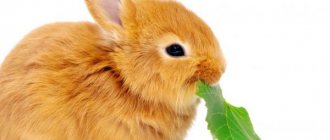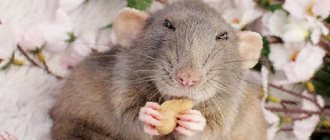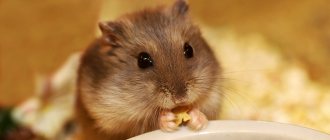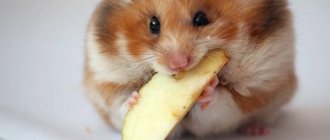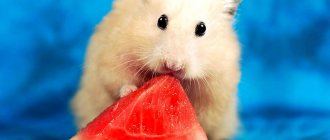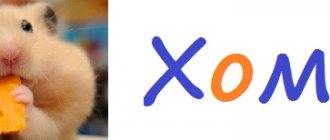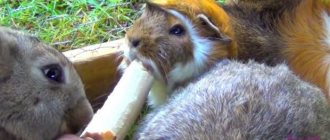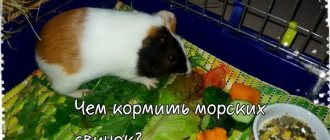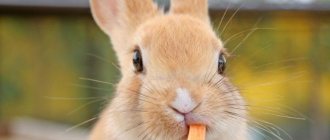- home
- Nutrition
06.04.2018
Nuts are a favorite treat for all domestic rodents, which is why happy hamster owners often treat their pets to various nuts. After all, these fruits have a lot of useful properties and are an indispensable source of a whole vitamin complex necessary for the proper nutrition of rodents.
However, before introducing nuts into your pets’ diet, you should carefully study all the nuances, namely, which of them can be given to hamsters without harm to health.
Is it possible to give walnuts to hamsters?
Walnut is very healthy as its core contains a large amount of proteins, minerals, vitamins and antioxidants. A special component is iodine.
This chemical composition has a positive effect on the heart and blood vessels and regulates digestive processes. Due to its fat content, walnuts have increased nutritional value. A small slice is enough for a hamster to get enough.
Syrian hamsters are larger than Djungarian and Campbell hamsters; they can have up to 3 pieces per day as a treat, but not more than 3 times a week. Smaller species such as Campbell's need to be given nuts in smaller quantities.
Djungarian hamsters should feast on these nuts minimally, because Djungarian hamsters are predisposed to obesity. Walnuts are a must for hamsters.
Cashews: against gray hair and osteoporosis
100 calories - 11 nuts
You can recommend these cute “bagels” to your grandmother or mother. “Firstly, cashews contain a lot of copper (100 g will more than cover the daily requirement), a deficiency of which causes hair to turn grey,” says Elena Tikhomirova. – Secondly, they are rich in magnesium, which, along with calcium and phosphorus, is responsible for bone density and strength and protects older women from osteoporosis. Finally, these nuts are a good source of tryptophan, an amino acid that our bodies convert into the happy hormone serotonin. It will protect against mood swings characteristic of PMS and menopause.”
Please note: All nuts are considered allergenic, but cashews and walnuts are the most likely to cause reactions.
Pine nuts in a hamster's diet
Pine nuts contain a large amount of carbohydrates, sugar, and have high fat content. Everyone enjoys eating them, especially Syrian hamsters, but they should be offered in small quantities.
High fat and sugar content can cause diabetes and impair liver function. Small breeds are prone to diabetes and obesity, so compliance with feeding standards is vital for them.
The portion for a Syrian hamster is 4 nuts per week, Dzungarik can have 2, Campbell needs one.
Any nuts must be thoroughly cleaned. Nut shells and husks from kernels clog the cheek pouches and are not digested in the stomach.
A hard shell can cause a hamster to break a tooth and get injured. It will be extremely difficult to treat the consequences.
Precautionary measures
Adding a new product to the diet of dzhungarika requires some precautions:
- When offering your pet nuts, consider its age, breed and size. The smaller the animal, the smaller the portion should be.
- Do not serve peanuts in the shell. Putting food in the cheek pouches can cause injury to your hamster. Peanut shells can cut your baby's esophagus and stomach.
- Do not overfeed your pet. Peanuts and hazelnuts have a high fat content, which disrupts the functioning of the animal’s digestive system. By overfeeding your animal with high-calorie foods, you harm its health.
- The animal must eat natural products. Peanuts should not be given after heat treatment.
- The rodent's diet should be varied. Offer him a different product each time.
- Do not give sweet, salty or spicy foods. Salted peanuts are harmful to the kidneys and liver.
Nuts are a tasty and nutritious treat. They have properties that are beneficial to the health of the hamster. However, it should be remembered that not all fruits can be included in your pet’s diet. Follow the feeding rules, and your pet will be healthy, cheerful and active.
Should you give hazelnuts to your hamster?
Hazelnuts are a source of vegetable protein, vitamin E and calcium, and are therefore beneficial for rodents. But it, like other nuts, contains a lot of fat (60-70%), so hazelnuts can be added to food no more than 1-2 times a week.
For a Syrian hamster, the daily portion cannot exceed half a nut. For Dzungariks and Campbell, a quarter of the core is enough.
Pistachios: for heart health and vegetarian nutrition
100 calories - 30 nuts
Well balanced in vitamins and minerals, relatively little fat, a lot of protein and plenty of opportunities to use them in a wide variety of dishes, from soups and salads to desserts and baked goods. Pistachios can be especially recommended for vegetarians. And for hearts: as a product rich in potassium and phytosterols. “An antagonist of sodium, potassium prevents the accumulation of excess fluid in the body, the appearance of edema, and the development of hypertension,” says Elena Tikhomirova. - Both it and phytosterols are beneficial for blood vessels. And the latter also reduce the level of bad cholesterol in the blood.”
Note. Pistachios are often sold salted, and this is not our choice
Eating 1/2 to 1 cup of these nuts will provide you with at least twice your daily salt requirement, according to the USDA National Nutrient Database. That is, sodium, a potassium antagonist. And thereby neutralize the beneficial effect of the latter.
Is it okay to give hamsters peanuts?
Peanuts contain vitamins B, C, PP, minerals and polyphenyls, which are antioxidants and are necessary for hamsters.
Peanuts strengthen the heart and blood vessels of hamsters. This is a good treat for your pet. Large species of hamsters, such as Syrians, should be given no more than 2 grains per day, small ones no more than 1, and no more than 2 times a week.
It must be remembered that only fresh nuts are healthy. It is unacceptable to offer store-bought nuts that have been heat-treated with the addition of seasonings.
Roasting peanuts with salt or sugar causes liver, pancreas and kidney diseases. As a result of metabolic disorders when eating heavy food, the hamster may die.
It will be good if you treat hamsters occasionally, 2 times a month, with pistachios, sunflower and pumpkin seeds, and sesame seeds.
It should be remembered that special food mixtures for feeding rodents contain the necessary components, so nuts and other baits must be given very carefully.
It is worth consulting with a breeder or veterinarian who will give recommendations, taking into account the characteristics of the breed, health status, weight and age of the pet.
What can you feed a rodent at home?
Food is dry and rough
Due to the sensitive digestion of chinchillas, they should not be given the following foods:
- food from the common table (salty, spicy, fatty, hot, smoked);
- meat and meat products;
- bakery products and baked goods (bread, pastries);
- flour (pasta, noodles);
- potatoes, fresh white cabbage, lettuce;
- sweets (cookies, chocolate, sugar, sweets, other confectionery);
- eggs;
- roasted nuts, seeds, grains;
- mushrooms;
- fermented milk products;
- fast food, chips, popcorn;
- stale and spoiled products.
The list does not contain absolutely any useful substances for the proper growth and development of the rodent. The listed foods are high in calories and fat, which can result in your pet becoming obese.
Even if your pet likes junk food, this does not mean that it should be offered.
Perhaps the animal will not die from just eating it, but systematically eating such delicacies will lead to serious health problems for the chinchilla.
We suggest you read: Cat tick bite first aid and treatment
Nuts that should not be given to hamsters
Almonds are poison for a hamster. It contains hydrocyanic acid, which causes severe intoxication, affects the nervous system and causes oxygen deficiency in the brain. As a result, the hamster may die.
Brazil nut is an extremely heavy and fatty food that is not absorbed by the body. Plus, the nut contains microelements that are toxic to rodents.
Acorns are also dangerous for hamsters; they contain too much starch, sugars, fatty oils and tannins.
They lead to difficulties not only with digestion, but also with urination. The most dangerous fruits are harvested in September; they cause poisoning and infections.
The grains of plums, apricots and peaches are poisonous to hamsters.
Almond
A forbidden treat for hamsters is almonds. This nut contains hydrocyanic acid, which is poisonous to rodents. Plum, apricot, and peach pits are no less dangerous. They are capable of killing a pet.
Whatever nut is offered to the hamster, it must be shelled. It is difficult for a furry pet to clean the fruit on its own. Even if he succeeds, the shell can damage the rodent's oral mucosa.
If you follow the above recommendations, sometimes treating your hamster to nuts that are healthy for him, he will delight his owners with his activity and cheerful disposition.
Results
To summarize and answer the questions regarding, can hamsters eat nuts and what kind? The answer will be - it’s possible, but within the permissible norm, literally a couple of nuts a day. Various types of nuts are possible - peanuts, hazelnuts, cashews, walnuts and pine. The main thing is to know that proper nutrition will ensure a long and healthy life for your pet.
Did you like the article? Share with friends: [supsystic-social-sharing >
- Related Posts
- Do hamsters drink water?
- Can hamsters have a banana?
- Can hamsters eat corn?
Choosing dry food
The diet of jungarians consists of 80-90% dry food. The hamster should receive it every day, this is the basis of the diet. Djungarian hamsters eat little (about a tablespoon of food per day), which means you shouldn’t skimp on store-bought formulas. Let's consider several brands of proven products:
Food for dwarfs
Versele-Laga "Prestige Mini Hamster Nature"
The completely balanced composition, in addition to grains and seeds, contains dried vegetables, fruits and nuts, a protein component and yeast as a source of vitamins. If your pet is prone to obesity, you need to manually select pineapple and raisins.
Chika-Bio "Food for Djungarian hamsters"
Domestic food, not inferior in quality to imported analogues, but more affordable. The size of the food particles and the ratio of ingredients are selected specifically for feeding jungarians.
Food for hamsters of any type of excellent quality
JR Farm Hamster
It has high palatability: dungarians feed by eating the entire food, rather than choosing individual tasty components. The “chips” of the food are a variety of protein sources (mealworms, chicken, tiny fish), the prebiotic inulin, which improves digestion, and yucca extract, which reduces rodent odor.
Vitakraft Menu Vital
Usually used for Syrians. The downside is that honey is added to the mixture to improve the taste. The diet of Djungarian hamsters involves limiting sugars.
Fiory Criceti
For dzhungariks, this food does not contain enough protein, and you will have to manually select appetizing, but harmful honey granules.
Cunipic
This food is characterized by a relatively poor composition.
Vitapol and Lolo pets
It is better to store hamster food not in a bag, but pour it into a glass jar with a tight lid. The mixtures are complete: you can give your Djungarian hamster only dry food for a long time. The reason to diversify the diet is the special physiological status of the animal: growth period, pregnancy and lactation, mating time for the male.
On our website you can learn about the correct feeding regime for a hamster. These are important rules that can protect your pet from obesity and poisoning.
Source
Water
When keeping in a city apartment, special attention must be paid to this point. Due to the requirements for water disinfection, liquid straight from the tap is of little use for chinchillas.
Especially in those regions where water is still disinfected with chlorine. Before giving such water to animals, it must be settled to get rid of chlorine compounds. And then boil, removing excess salt.
If you don’t want to take risks, you can buy bottled drinking water in a regular store. Now there is an opinion that such water is even worse than tap water, but there is no chlorine or bacteria in the bottles. In the case of chinchillas, this is the main thing.
To prevent chinchillas from polluting the water, it is better to use nipple drinkers. Such drinking bowls are closed on almost all sides, and in order to drink from it, you need to move the locking ball.
